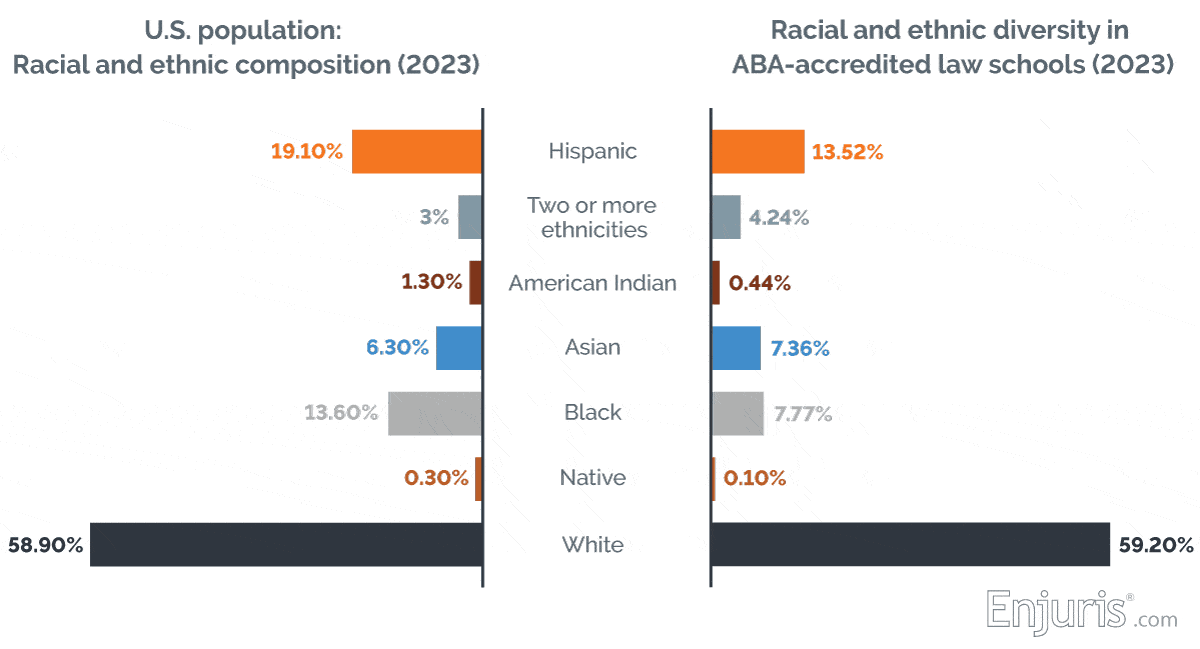
The American Bar Association (ABA) gathers comprehensive Standard 509 data from law schools annually, providing a detailed snapshot of legal education across the country.
The latest data for 2023 has just been released, offering fresh insights into the ten law schools and more than 6,500 law students in Texas.
Gender demographics in Texas law schools
At the dawn of the 20th century, women comprised less than five percent of all law students in the United States. This figure climbed to 48 percent by the century's end, and in 2016, the number of female law students exceeded that of their male counterparts for the first time.
Since overtaking men, the gender gap has grown every year. In 2023, women accounted for 56.25 percent of law students, while men comprised 42.85 percent. This trend is reflected nationwide, with 86.29 percent of law schools reporting more female students than male students.
In 2023, 18 of the top 20 law schools ranked by U.S. News & World Report had more female students enrolled than male. To put this in perspective, in 2016 — the first year female enrollment surpassed male in law schools — only four of these top 20 institutions had more female than male law students.
Texas has ten ABA-approved law schools. Here's a closer look at their gender demographics:

*A small number of students chose to identify as “another gender identity” or opted not to disclose their gender.
As women increasingly dominate law school classrooms, there is a corresponding and dramatic decline in male enrollment.
The number of men in law schools has declined every year for the past 13 years—from 78,516 male enrollees in 2010 to 50,097 male enrollees in 2023.
Examining the origins of the contemporary educational disparity sheds light on the decline in male law students. In the U.S., girls are 14 percent more likely to be prepared for school than boys at the age of four. By high school, females dominate the top tenth percentile, while males dominate the lower tenth.
Currently, the enrollment ratio in U.S. colleges and universities favors women, with a ratio of six women to every four men. This pattern isn't recent; since the mid-1980s, women have consistently outpaced men in earning bachelor's degrees.
Brookings Institution Scholar Richard Reeves pointed out that men accounted for 57 percent of college and university students in 1970. Two years later, Congress passed Title IX to prohibit sex-based discrimination in schools that received federal funding. The gender gap is much larger in the other direction today, begging the question: What, if anything, should be done about it?
Racial and ethnic demographics in Texas law schools
The total number of minorities enrolled in law school in the United States increased for the sixth year in a row in 2023, and the percentage of minorities enrolled in law school increased for the fourth year in a row.
The racial and ethnic composition of law students in ABA-accredited law schools in 2023 comes close to reflecting the racial and ethnic demographics of the United States population as a whole. The infographic below displays the total percentage breakdown of ethnicities and races in the U.S., according to the most recent United States Census Bureau data, and compares it to the total percentage breakdown of ethnicities and races in all ABA-accredited law schools.

The most significant disparity in representation between the general population and law students is among students identifying as Black (13.6 percent compared to 7.77 percent), followed by law students who identify as Hispanic (19.10 percent compared to 13.52 percent).
Here’s how the Texas law schools compare:

The latest ABA data paints a clear picture of shifting demographics in Texas law schools, with notable trends in gender and racial diversity. For Texas attorneys, grasping these changes is critical for navigating the evolving legal landscape and meeting the diverse needs of our communities.
